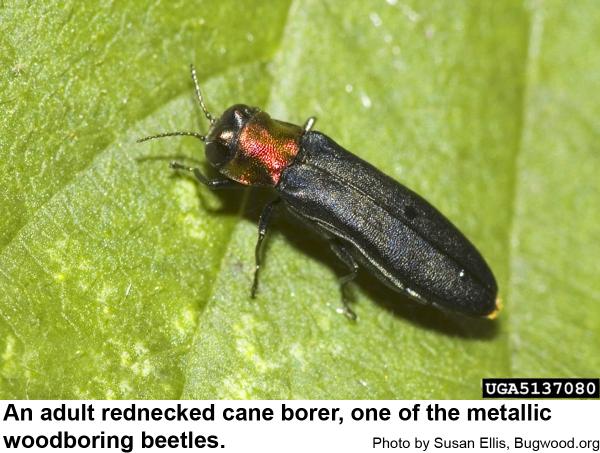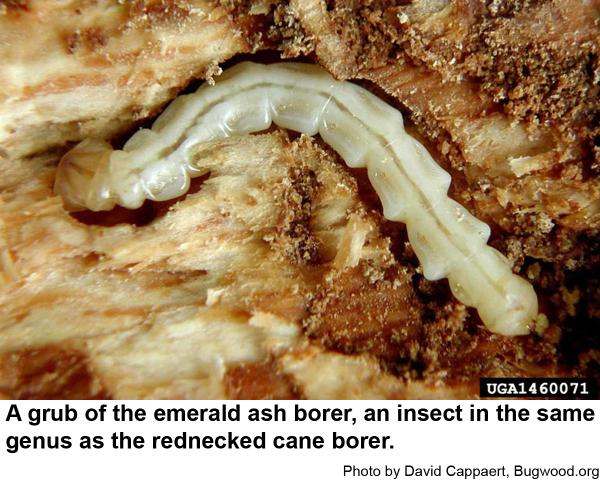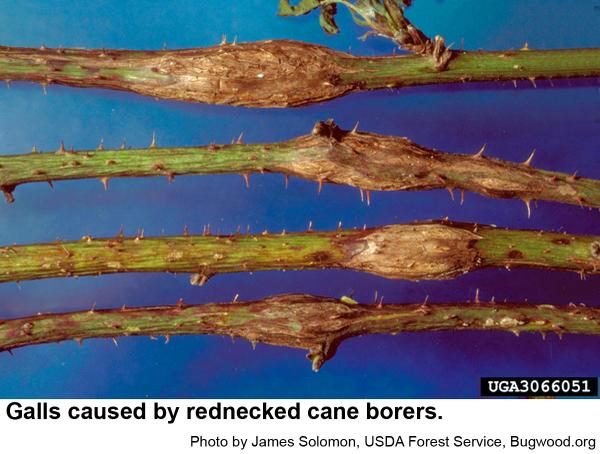Description and Biology
The rednecked cane borer, Agrilus ruficollis , is a small, slender, metallic wood boring beetle that emerges from April to July. These beetles are metallic blue-black with a coppery thorax and are 1/2 inch long. Adults mate and females glue eggs on the bark of stems usually near a leaf. From that hatches a tiny, slender, boring flatheaded beetle grub that chews directly into the cane and tunnels in a spiral fashion around the cane. This causes cigar-shaped swellings 1 to 3 inches long in the canes. Tunnels may extend 6 inches below to 25 inches above the gall. Rednecked cane borer grubs are white, legless, and wide just behind the head. They grow 5/8 to 3/4 inch long when mature. Most galls are found at ground level but can occur up to 4 feet above the ground. Pupae are about 1/2 inch long and more or less shaped like adults. New beetles feed on young foliage for several days before laying eggs. We have one generation per year in North Carolina.
Host Plants
Rednecked cane borers infest blackberry, dewberry and other plants in the genus Rubus. Their galls often split the bark. The stem may break off there. Infested canes die or become so weakened they cannot support a crop the following season. Rednecked cane borers may infest as much as 50 percent of the canes in one or two year old plantings. Damaged canes are predisposed to winter injury.
Residential Recommendations
Because females cover their eggs with a yellow viscous material that fades to white or grey and the grubs exit the egg directly into the plant, gubs are never exposed, and so are impervious to sprays. Because the rednecked cane borer adults emerge over a fairly long period, probably the best control is to prune out and destroy infested stems as soon as the galls are noticed. Grubs normally tunnel upward into the pith, but When looking for overwintering grubs it is best to split the cane at the gall and follow the brown, discolored tunnel from the gall to its end. Live grubs are rarely found in the gall. Up to 75% of rednecked cane borer grubs die due to fungal diseases, parasitic wasps and unknown causes, but that leaves 25% to carry on the wheel of existence. If more than 5% of canes have galls, chemical control may be warranted to try and control females before they oviposit. Begin scouting planting during bloom by looking for adults during daylight hours. Don't start insecticide applications until after bloom has ended to avoid killing bees and other pollinators. Be sure to use an insecticide labeled for blackberries.
Other Resources
- Guide to Insect Borers in North American Broadleaf Trees and shrubs. Solomon, J. D. 1995. USDA Forest Service Agr. Handbook AH-706. 747 pp.
- Rednecked and Raspberry Cane Borers. Bessin, R. 2019 (revised). University of Kentucky College of Agriculture. ENTFACT-209.
- Rednecked Cane Borer. Pfeiffer, D. G. 2019 (copyright). Virginia Tech. 3104-1562 (ENTO-210NP)
- NC State Extension Plant Pathology Publications
- NC State Horticultural Science Publications
- North Carolina Agricultural Chemicals Manual
For assistance with a specific problem, contact your local N.C. Cooperative Extension center.
This factsheet has not been peer reviewed.
Publication date: March 26, 2019
Reviewed/Revised: Jan. 10, 2024
Recommendations for the use of agricultural chemicals are included in this publication as a convenience to the reader. The use of brand names and any mention or listing of commercial products or services in this publication does not imply endorsement by NC State University or N.C. A&T State University nor discrimination against similar products or services not mentioned. Individuals who use agricultural chemicals are responsible for ensuring that the intended use complies with current regulations and conforms to the product label. Be sure to obtain current information about usage regulations and examine a current product label before applying any chemical. For assistance, contact your local N.C. Cooperative Extension county center.
N.C. Cooperative Extension prohibits discrimination and harassment regardless of age, color, disability, family and marital status, gender identity, national origin, political beliefs, race, religion, sex (including pregnancy), sexual orientation and veteran status.




